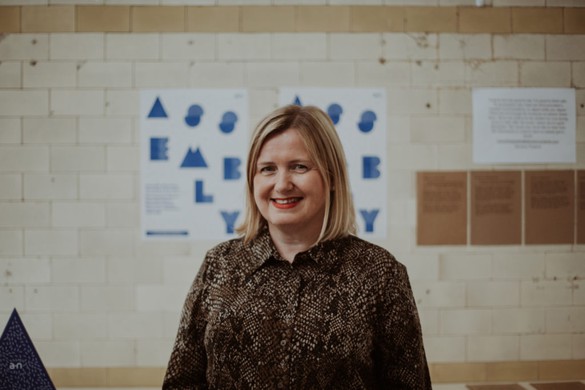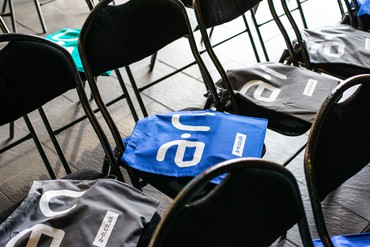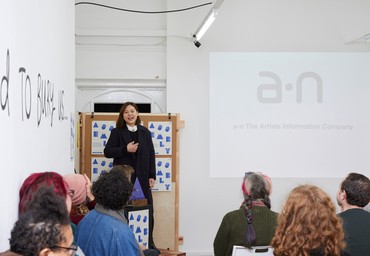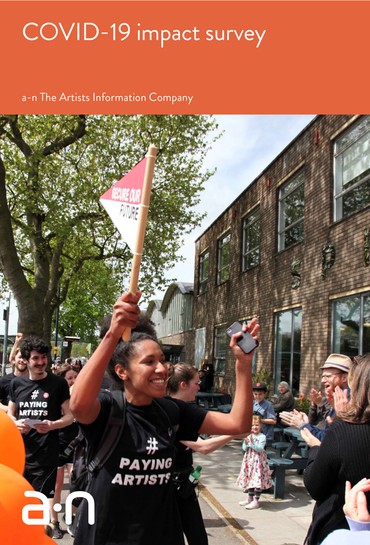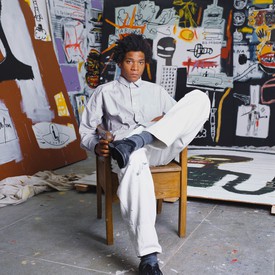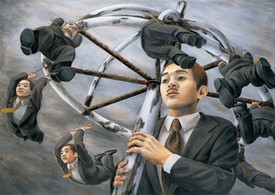
Julie Lomax is chief executive officer of a-n The Artists Information Company.

Rani Singh is director of special projects at Gagosian, Beverly Hills. Her work focuses on strategic planning and legacy management for artists, exhibitions development, museum outreach, and programming.
In late April 2020 Julie Lomax, of a-n, and Craig Davies, a partner in the London office of accounting firm Rawlinson & Hunter, convened a group of artists, arts workers, and Gagosian staff members for a webinar to discuss financial relief funding available to artists during the COVID-19 pandemic. The conversation covered a broad range of topics, including government initiatives, Arts Council England’s grant program, and the Time Space Money bursaries distributed by a-n. Two weeks later I followed up with Julie to see what had transpired in this rapidly changing landscape in the time since. We discussed the extension of the government’s furlough scheme and the expansion of the business loan scheme, both of which will bring relief to many artists and arts workers. We also talked about the ways artists are responding to the crisis.
—Rani Singh
Rani Singh In the webinar, you gave us very smart, practical advice that in times of crisis, it’s important to pause and take stock and reassess your priorities. These are things to think about at all times, but even more so now. Could you speak to that idea?
Julie Lomax One of the things the crisis has highlighted is the fragility of, and also the differences around, the various business models that artists employ. For instance, an artist may be a sole trader, or a company, or they may work on a freelance basis, with some sales here, some teaching there—there might be a portfolio of what they do. Whatever the model is, it’s really important to have a plan for your role in your business: to know who you work with, what your spheres of influence are, what your commitments are, how often you need to be in touch with people, and so on. For artists, that type of plan is often overlooked, because obviously your practice becomes the primary focus of what you do. But surrounding that practice is a whole network of contacts, and if you don’t have an understanding of how your business interacts with them, you could be affecting the way that your practice is mediated and gets out into the world, whether through exhibitions or sales. It’s important to understand what level of contact you might need to have with people, what level of relationship, and then set regular reminders to be in contact with them, whether it’s once a year or every three months or more often than that.
When we talk to artists, we encourage them to think of themselves and their practice as the business plan. The business plan is not only about what you do, but also how you do it. For instance, how do you actually look after yourself in your business? How do you look after your own well-being? In my role, I have five weeks’ paid holiday a year. How does that work if you’re an artist? How does that work if you need to take sick leave as well? There will be moments where you have to do a bit of administrative work. If you’re not good at that, get somebody else to do it for you. Get that plan in place so that all you have to do is focus on the contacts and the relationships and somebody else does all of the planning.
The type of business structure that you choose should be defined by the way you want to work. There are certain givens, in that at some point you will have to pay taxes, you might need a loan, or enter into a property agreement—but the overall business structure should be very personal to the way you want to work.
One of the things the crisis has highlighted is the fragility of, and also the differences around, the various business models that artists employ.
Julie Lomax
RS Have there been any updates on funding opportunities since our last conversation that you’d like to discuss?
JL One of the things that has come as a bit of a relief is that the government’s furlough scheme—which was only available until June when we originally spoke—is now available until October this year. The chancellor has indicated that it won’t just stop, that there will be some phasing out, and we don’t know exactly what that looks like yet. But that gives people time to really assess how the workforce comes back to work, because there are very stringent health and safety guidelines for keeping staff members safe. The government recently released comprehensive guidelines. The most important things to note are that every workplace has to carry out a risk assessment before employees can return to work, social-distancing measures are still in place, and where possible the advice is to work from home if you can.
Extending the furlough scheme has definitely been very positive. There is also new flexibility built into the scheme to bring employees back in to the workplace on a part-time basis.
The other good news is that now there is much more take-up of the business loan schemes. The government has obviously put some pressure on the loan companies and the banks, to provide those loans and to get them out quickly. That will be very important for small businesses, though it also applies to bigger and medium-sized businesses. It’s a simpler application process, and the loans are now one hundred percent guaranteed by the government. I know from when I was director of visual arts at Arts Council England that artists very rarely default on loans. Small businesses and artists don’t really default on loans. It’s more likely to be bigger businesses. It’s extraordinary.
It’s a good idea also to check if your business or studio is eligible for a small business grant; we were able to get one for a-n, and it certainly is a lifeline in these difficult times.
RS That’s really interesting.
JL At a-n we’re also doing some work on the self-employment scheme, because some people have come back to us and said, “We’re not eligible.” We always knew that there were a number of people who were falling through the gaps, and that’s to do with taxation laws in the UK, specifically IR35 legislation, where people may be doing a couple of hours teaching or one lecture at a university and they’re being put on payroll rather than being treated as self-employed. So when they apply for the self-employment reimbursement, they’re not getting it. We are doing some work on that and we have done some advocacy to the Treasury.
The Freelands Foundation put four million pounds into this ecosystem. The fact that we’re able to distribute these funds very quickly is a fantastic outcome.
Julie Lomax
RS Can you tell us about the Freelands Foundation Emergency Fund? Who is it targeted to, and how does it work?
JL The Freelands Foundation are a private, not-for-profit foundation. They’re registered in the US and the UK, and they have been set up to support artists, in particular visual artists. They have made in total four million pounds available to artists and freelancers—people who work with artists to help them either exhibit or make their work. They’ve already distributed a million pounds through Creative Scotland and five hundred thousand pounds through Arts Council Wales. For England and Northern Ireland, they came to a-n for us to distribute the funds. There was a million pounds for artists and freelancers working directly with artists to help them make or exhibit their work in England, and half a million pounds for artists and freelancers based in Northern Ireland; the scheme is closed for applications but will open again for projects and grants for Northern Ireland.
We do get a lot of inquiries about what it means if you’re a freelancer who isn’t an artist. You have to show that the majority of your work is in the visual arts sector. This could be as a technician, or in support services, or in marketing and PR. You can still apply, as long as the work that you’re doing is with artists and institutions in the visual arts sector.
It’s about securing funding for people who have lost income through having contracts canceled, or if they have ongoing expenses related to their practice or their work. For instance, if you’re an artist, this could be studio rent; if you’re a technician you may have subscriptions or insurance policy upkeeps that you have to have as part of your work. It’s really to replace lost income and to ensure that the hardship funding is spent on expenses that help you in your working life.
RS Is the money given in a weekly allotment?
JL Yes. Internally, we’re having weekly decision-making meetings, and we have a peer review process. We have an artist on the panel, Hetain Patel, and Lucy Day, who is an independent curator and does a lot of work mentoring and coaching artists, as well as career development work. The panel will be chaired by either me or my program manager, Wing-Sie Chan, and we will make around a hundred grants a week. This might shift, obviously—some weeks we might receive fewer applications, some weeks we might receive more—but we will push through these decisions as quickly as possible.
RS It’s very impressive to see how nimble and responsive your team is, and also the fact that the fund targets a wide range of arts workers. Oftentimes, those are the people who get left out.
JL Yes, many of them are artists themselves, especially studio assistants, technicians, and art handlers. They’re doing that work to supplement their practice and that’s why they do it on a freelance basis. Massive credit to the Freelands Foundation to say they are going to put four million pounds into this ecosystem. The fact that we’re able to distribute these funds very quickly is a fantastic outcome.
RS Can you tell us about your impact survey? How many people were part of the survey, and what are some of the takeaways that you gleaned from the respondents?
JL We conducted the survey very early in the crisis, between the 19th and the 24th of March. At that point in the UK, we had social distancing measures in place, and what we really wanted to know was the immediate impact of COVID-19 on artists’ livelihoods. But we also asked some questions on what they thought that we should do in response to it, and what they felt the future might look like.
what starts in the studio as a solo practice actually does rely on a thriving visual arts sector; it absolutely relies on audiences, relationships, and connections, and over the last two to three months many of these have broken down.
Julie Lomax
We had 4,070 responses, or around fifteen percent of our membership of just over 25,000 across the UK. Ninety-three percent of respondents said that COVID-19 had impacted them in some way. One of the big things we learned from the survey was the anxiety for artists around not being able to go to their studio. We’ve seen artists adapt to that now under lockdown. But the survey results were a reminder of how precarious the arts actually are. It told us that what starts in the studio as a solo practice actually does rely on a thriving visual arts sector; it absolutely relies on audiences, relationships, and connections, and over the last two to three months many of these have broken down. Artists have been asked to navigate through complex structures, and not everybody has a gallery to assist them with these matters, as you know.
What we’ve done with the survey is to use it to advocate on behalf of our members. It has also exposed the bigger issues that need attention, such as interpretation of the IR35 tax legislation as it applies to large institutions and museums, and the fragile business models of artist-run studio facilities, and also how artists set themselves up as a business or a sole trader. These are the things that have come out of it, which we know that we have to do more work on. It’s very clear to us at a-n that artists need affordable and easy-to-understand tax and legal support. It is important that we use the information not just to advocate, but to think about the big picture and what we need to work on next.
RS What is most striking is the precarious balance for artists across the spectrum. Like many small businesses or sole proprietors, many artists do not have a plan in place for a three-month stopgap in income, let alone something longer.
JL Definitely. If you’re a very small studio, you can move quite quickly to adapt. And if you’re very big, you’ve probably got some capital behind you that will help you through what may be a more difficult time: you may be able to employ someone to take a forensic look at your business and think about what you may need to change. In the middle, it’s more challenging. They’re likely to be less nimble than a small studio and might not have the capital to employ advisors to help look at what the plan is going forward.
RS What advice would you give to artists about going forward in this climate—about how to make work and to reach their public?
I think it’s important that institutions do a pause-not-panic moment and talk to artists, because artists always know the best way that they would like their work to be mediated.
Julie Lomax
JL I think that one of the things that has come out of this is a kind of institutional mourning. People can’t work in the way that they normally work, so there’s a mad scramble to rethink how the institution works, and everybody is going digital. But I think it’s important that institutions do a pause-not-panic moment and talk to artists, because artists always know the best way that they would like their work to be mediated. And artists need to feel that they can stop and look at what institutions are asking and whether it actually works for them. It’s okay to go dark for a while. Most people engage in the arts because of the tangibility of it, the real tangibility. I don’t see a world where we live completely digitally yet. People want to go and see things and really experience them. So I do think that when you’re rethinking your practice around online content, make sure that it feels right for you and for your practice. I have seen the most amazing things come out of artists working from home and rethinking their practice.
Another thing that’s been extraordinary is the Artist Support Pledge. It’s already generated twenty million pounds worth of sales. It’s extraordinary how that has been working, artists buying other artists’ work through the sale of their own work.
RS Can you explain how the Artist Support Pledge works?
JL Matthew Burrows, a British artist, started the initiative on Instagram, inviting artists to post works for sale for up to two hundred pounds each, and when the artist reaches sales of a thousand pounds, they pledge to spend two hundred pounds on another artist’s work.
It’s interesting, because it’s a very democratic platform—it’s not curated. But it’s clear that there are artists out there who are making work that not only is selling, but is being bought by other artists who are actually very well regarded and endorsed by the industry. If I was a curator, or if I was in the market, I would have an eye on it. It’s a very interesting model, and all it took was an Instagram account—nimble and easy. I love the spirit of it.
Photos: courtesy a-n The Artists Information Company
